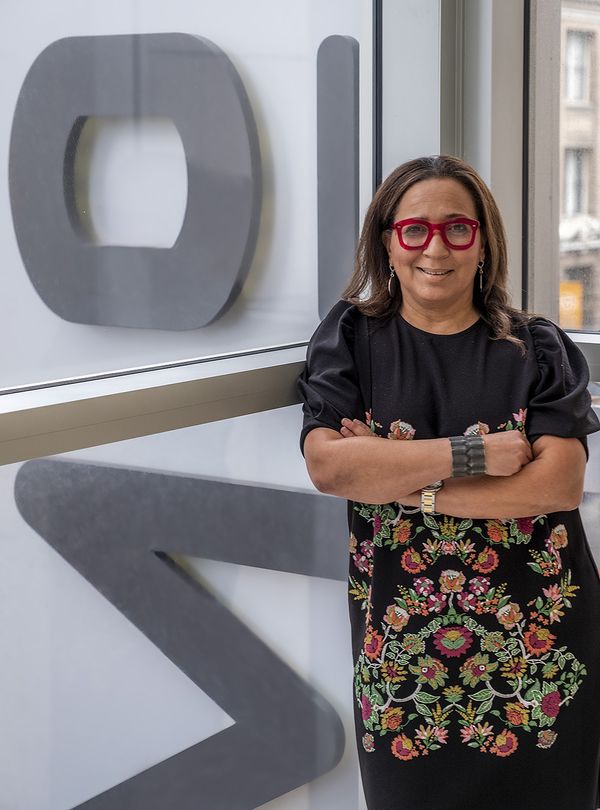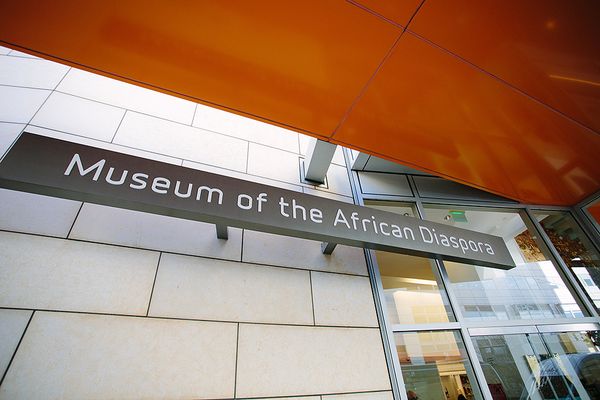PHILLIPS: The Museum of African Diaspora is just under 20 years old. What are some of the museum’s signature programs that you are most proud of?
MONETTA WHITE: As one of the only museums dedicated to contemporary art practices of the African diaspora, MoAD holds an important space not only globally but also as an important platform for our local artistic communities. The Emerging Artists Program (EAP) is an open call for Bay Area artists to present solo exhibitions of their work. Lead by Elena Gross, this program is often the first time artists can work with museum staff to present their vision from its inception to closing celebrations.
Sustaining engagement with youth and developing visual literacy is a pillar of our MoAD in the Classroom (MIC) program. Focused on the third grade, students from all over the Bay Area — specifically from Title I schools — participate in an arts-centered curriculum designed to be taught both in the classroom and through on-site visitation at MoAD.
[Our] exhibitions interrogate various veins of complexity, as artists and curators approach contemporary issues resulting from historical diasporic movements. —Monetta White
As a non-collecting institution, we have a unique ability to invest in the voices and visions of independent curators. From international traveling exhibitions such as Africa State of Mind to exhibitions organized at MoAD, including Coffee, Rhum, Sugar & Gold: A Postcolonial Paradox, the exhibitions interrogate various veins of complexity, as artists and curators approach contemporary issues resulting from historical diasporic movements.
Bryant Terry continues to be a beacon and important member of MoAD. As our inaugural Chef-In-Residence he creates programming that celebrates the intersection of food, farming, health, activism, art, culture, and the African Diaspora. With his current online programming, Choppin’ it Up with MoAD, and his most recent book Vegetable Kingdom, Bryant expands the understanding of what an art museum can do.

MoAD Executive Director Monetta White.
P: MOAD is a part of a very dynamic group of San Francisco art museums. In your opinion, what are some of the factors that have led to this collaborative environment?
MW: Our collective dedication to fostering a healthy and vibrant arts ecosystem has engendered multiple and simultaneous partnerships across platforms. With a spirit of learning from and supporting each other, we love working with our colleagues at SOMArts, the San Francisco Public Library, and YBCA. In coming together, we present unique opportunities to support our shared audiences and create a dialogue with experienced and unique voices. Institutional collaboration has been instructional as we are all grappling with the horizons of change and our mutual support of one another has truly been a lifeline over the last six months.
It is so gratifying to discover new things about yourself and the world through your work. I am fortunate enough to do that on a daily basis at a contemporary art museum. —Monetta White
P: While you have been involved with MOAD from its inception in 2004, your professional background is outside of the museum world. What has been the most welcome surprise in making this transition and taking the helm?
MW: While initially hesitant about continuing my career in a new industry, MoAD has only inspired me to think bigger than ever before. I come from an entrepreneurial background and I am thrilled to be able to bring aspirational, out-of-the box ideas to the institution. It is so gratifying to discover new things about yourself and the world through your work. I am fortunate enough to do that on a daily basis at a contemporary art museum.

P: How has MOAD transitioned its exhibitions and programming to meet the needs of an increasingly digitized world?
MW: Even as our doors closed, our programs never stopped. The energy and dedication of the staff has enabled the migration of many of our in-person programs online. Our Senior of Director of Education, Demetri Broxton, has organized In the Artist’s Studio, a weekly conversation between artists from across the country including Erica Deeman, Bisa Butler, and Dr. Fahamu Pecou, among others. From open mics to art workshops, exhibitions tours to film series, the digital space has enhanced our programmatic offerings to extend to not only people able to visit our brick and mortar, but also to people tuning in from all over the world. At this moment, we are tracing, enacting, and celebrating the importance of the African diaspora, as we engage global audiences.
P: What are some upcoming projects you are most excited about?
MW: When shelter-in-place was enacted in San Francisco, MoAD was in the middle of our installation process of four incredible exhibitions. While we were obviously disappointed in the delay of their openings, we are looking forward to the long-awaited solo exhibitions of Mary Lovelace O’Neal, David Huffman, Sam Vernon, and our next Emerging Artist Sydney Cain. While all of these artists live and work in the Bay Area, they are of different generations and have unique relationships to the arts community here. I am looking forward to viewing their diverse practices, in tandem, and thinking about the important, underrecognized work of artists in the Bay Area.
With 2021 just ahead of us now, I am so looking forward to Billie Zangewa’s first US solo museum exhibition, Thread for a Web Begun, curated by Dexter Wimberly, that will debut at the Museum and travel across the country. This exhibition, along with our annual ENGAGE Symposium in February will be the highlights of my year. In preparation for thinking about the months and years to come, we have launched Future Forward, our current online fundraising campaign, raising support for the continued sustainability of the Museum. This campaign will ensure the ongoing exhibitions, programs and educational opportunities offered to our visitors when we can open our doors again.

Discover More about the Museum of African Diaspora >
